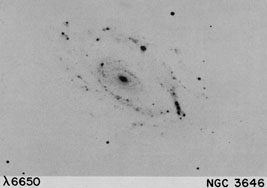


NGC 3646. - This galaxy has been discussed by
Burbidge et al. (1961c),
who note that there appears to be a considerable amount of dust
between the inner and outer ellipses of this large object. The
100-inch (2.5-m) and 90-inch (2.3-m) blue photographs strongly suggest
the presence of dust as distributed in the sketch. The bright HII
regions identified on the ON and Off
H plates are clearly associated
with the more obvious dust lanes. For this galaxy, the redshift of
about 4000 km s-1 is second only to
NGC 2532 (v
plates are clearly associated
with the more obvious dust lanes. For this galaxy, the redshift of
about 4000 km s-1 is second only to
NGC 2532 (v
 5200 km s-1) in the
sample chosen for this study. These two galaxies have several
similarities; their inner spiral arms are similar in size and
structure, they each have complex outer structure of very great extent
(outer bright HII regions at distances of the order of 18 kpc from
their respective nuclei if H = 75 km s-1 Mpc-1),
and there is evidence
for the presence of extensive dust lanes defining a spiral pattern
throughout each galaxy.
5200 km s-1) in the
sample chosen for this study. These two galaxies have several
similarities; their inner spiral arms are similar in size and
structure, they each have complex outer structure of very great extent
(outer bright HII regions at distances of the order of 18 kpc from
their respective nuclei if H = 75 km s-1 Mpc-1),
and there is evidence
for the presence of extensive dust lanes defining a spiral pattern
throughout each galaxy.
There is, in fact, even a suggestion of a wavy segment of a spiral
arm in the outer region of each galaxy. This wave structure in
NGC 3646 is on the NE side of the galaxy.
Burbidge et al. (1961c)
have
suggested that the wave represents an instability (on a scale of about
900 pc). A comparison of the ON and OFF
H photographs suggests that
the composition of the wave is not a young population of dust and HII
regions but rather that it is a mixture of stars whose combined light
is of a color red enough to be recorded in the red continuum as well
as in the blue.
photographs suggests that
the composition of the wave is not a young population of dust and HII
regions but rather that it is a mixture of stars whose combined light
is of a color red enough to be recorded in the red continuum as well
as in the blue.

| 
|

| 
|